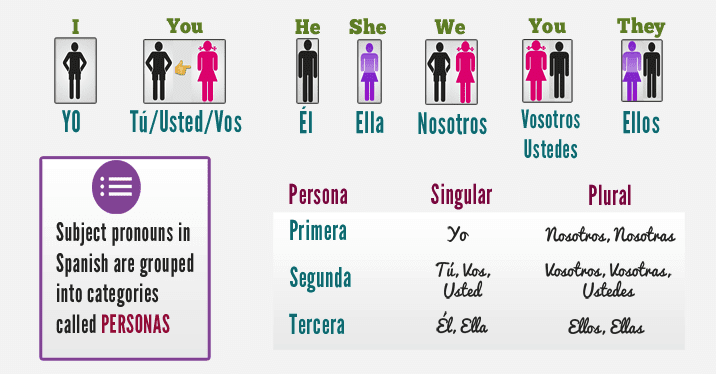What is a subject pronoun?
A subject pronoun is exactly what it sounds like: a pronoun that takes the place of a noun as the subject of a sentence. Remember, a sentence’s subject is the person or thing that performs the action of a verb.
How do you use subject pronouns in Spanish?
Subject pronouns always need to agree in number with the verb, just like in English.
A verb is a word that depicts an action. For example:
- walk
- stand
- drink
- cry
- wait
- write
The original form of a verb is known as the infinitive. In the English language, we put the word “to” in front of each verb to indicate that it is an infinitive.
- to walk
- to stand
- to drink
- to cry
- to wait
- to write
The infinitive is like a chameleon that changes color to match the color of whatever it is touching. Well, the infinitive of the verb changes to match the subject of the sentence it is used in:
| Subject Pronoun | Verb |
| I | drink |
| you | drink |
| he/ she/ it | drinks |
| we | drink |
| you | drink |
| they | drink |
Note: The above forms are called conjugations of the infinitive “to drink.”
What are the 10 Spanish pronouns?
The words listed below are known as subject pronouns. Just like English, Spanish has its own subject pronouns. The English pronouns are listed below with their matching Spanish pronouns.
| English | Spanish |
| I | yo |
| you | vos |
| he/she | él/ ella/ usted |
| we | nosotros/ nosotras |
| you | ustedes |
| they | ellos/ ellas |
As we have discussed in previous grammar blogs, Spanish is a very gender specific language. We can see this displayed in our use of subject pronouns.
For example, let’s talk about “nosotros” for a moment. This means “we” if we are talking about a group of males, or a group of males and females (refer back to our blog on gendered nouns). If the group contains only females, then you must use “nosotras” . This means, that in Spanish, we have to words for “we”.
- nosotros: we (masculine or mixed group)
- nosotras: we (feminine)
This same idea applies to the English word “they”
- ellos: they (masculine or mixed group)
- ellas: they (feminine)
So, to review, below is a complete list of the Spanish pronouns in their singular and plural forms:
Singular
- 1st person: yo – I
- 2nd person: vos – you (familiar)
- 2nd person: usted – you (formal)
- 3rd person: él – he (masculine)
- 3rd person: ella – she (femenine)
Plural
- 1st person: nosotros – we (masculine or mixed gender)
- 1st person: nosotras – we (feminine)
- 2nd person: ustedes – you-all
- 3rd person: ellos – they (masculine or mixed gender)
- 3rd person: ellas – they (feminine)
Now you have learned all of the subject pronouns in Spanish and how to use them. This will come in handy when you are trying to tell a story or anecdote in Spanish and you will not have to say everyones name ten thousand times. Try to advantage of the next opportunity to tell a story in Spanish and practice what you have learned!




